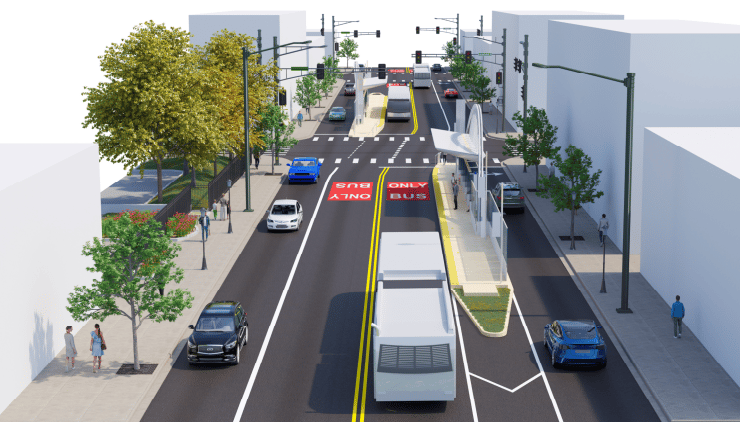Updated Oct. 31 at 2:15 p.m.:
Denver City Council voted on Tuesday to move the Colfax rezoning proposal from the Land Use, Transportation and Infrastructure committee to the full Council, which will vote on the bill in the next few weeks.
The rezoning would include more than 6,700 properties, and is aimed and promoting pedestrian-friendly development along what will become Denver's Bus Rapid Transit line. That transit project, along with commercial-centered rezoning, is expected to bring job growth along Colfax Ave.
"This is the result of about three years worth of hard work and coming together with our communities and business owners and property owners and residents," said Councilmember Amanda Sawyer, one of the sponsors of the rezoning proposal.
Our original story continues below.
Walking down East Colfax, plenty caters to the casual passerby: coffee shops, restaurants, the City Park Farmers Market.
But other areas make one wonder, "How did that end up there?" Sprinkled between decades-old bars and tattoo shops are empty lots, storage facilities, car dealerships and that Starbucks that only does drive-through service.
While it might not look like it just yet, Colfax is undergoing a transformation from its car-centric history to a transit-oriented future as the city works on a bus rapid transit line (BRT) that will bring a faster RTD bus line to the longest commercial street in the U.S.
Planners expect it to open in 2026, and officials say it will speed up public transportation along Colfax, transform parts of the street and promote economic growth.
City Councilmembers Chris Hinds and Amanda Sawyer say they want to make sure the surrounding properties can keep up. They announced a plan to rezone a large stretch of Colfax Ave. between Broadway and Yosemite to promote "walkability and vibrancy," according to a statement released last week. Former Councilmembers Chris Herndon and Candi CdeBaca also worked on the proposal, which includes parts of Colfax in the four Councilmembers' districts.
"The gist of the overlay is to prioritize people over stuff," Hinds said.
Hinds said the idea came when he heard in 2021 that a credit union wanted to open a drive through near Colfax and 14th Ave. Then he heard about a proposed storage facility north of Colfax on Pearl St. -- neither of which would serve pedestrians.
While the specific zoning uses for land will remain the same, the proposed plan would create design standards on certain parcels along Colfax.
This would include restrictions on things like drive-thrus, storage facilities and carwashes in order to promote businesses facing future BRT stops that cater to pedestrians. The zoning also includes a setback - building a set number of feet back for better sidewalk access - and other design guidelines at the street level. The plan does not include every parcel but focuses on wide ones near BRT stops. It also only applies to new developments. It would not change parking requirements or allow for building uses currently prohibited along Colfax.
"The goal for the BRT is to move people, not things," Hinds said. "You're not going to take the BRT to go to a carwash, or you're not going to take the BRT to go to the drive thru."

Similar zoning changes have happened in commercial areas before.
Councilmember Amanda Sandoval took a similar approach to zoning on Tennyson in District 1, and former Councilmembers Jolon Clark and Council President Jamie Torres recently applied the guidelines to parts of Santa Fe.
"I wholeheartedly support the vision of making Colfax more walkable and more pedestrian friendly," said Monica Martinez, executive director of The Fax, a nonprofit focused on equitable development along Colfax. "On the other hand, now I'm a property owner, and I also am aware of the impact of this overlay on the development potential of sites ... That'll impact the finances of projects for certain."
The Fax owns two motels on Colfax just outside the proposed overlay, which the group plans to develop into shelter space. She recognized that requiring a setback for new developments along certain parcels will decrease value for developers. Martinez thinks City Council should consider incentives, such as rezoning for additional floors, for owners in that situation. She warned the additional complexity of the overlay will add cost and time for developers during a housing crisis. But she supports the overall plan.
"It was too easy just to plop down a car dealer, carwash, gas station, and we didn't prioritize our people. We prioritized our cars," she said. "I think the development type is good, but there's always tradeoffs with public policy decisions... I want Colfax to be a pedestrian friendly, pretty environment where people will want to live."
Hinds and Sawyer plan to look at final input from recent community meetings before bringing the plan to Council's Land Use, Transportation and Infrastructure committee for consideration.
Editor's note: This article was corrected with the street that previously received a similar overlay -- that street is Santa Fe, not Broadway.













